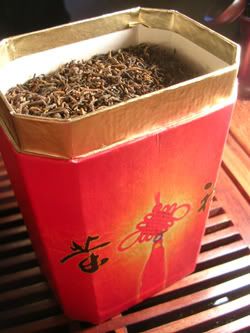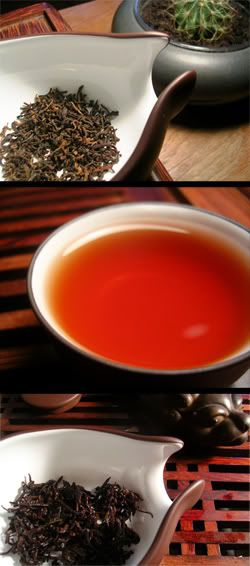 First up is the veracity of its claim to age. Regular readers might remember the Maguan Panguwang bing that Lei bought in quantity to fulfil her daily shupu drinking. Tea Logic's VL pointed out that the wrapper was reminiscent of the style that became popular in 1999 - recalling that the tea vendor in Lei's hometown claimed he purchased it in 1997. Going solely on the characteristics of the tea, my impression is of something in excess of 7 years (of which we have a fair number of examples). Given also that the vendor is (as I understand) a trustworthy friend of the family, the scales tip in his favour. Perhaps it is unimportant, given the pleasing outcome of the tea (and it's price that asymptotically approaches zero).
First up is the veracity of its claim to age. Regular readers might remember the Maguan Panguwang bing that Lei bought in quantity to fulfil her daily shupu drinking. Tea Logic's VL pointed out that the wrapper was reminiscent of the style that became popular in 1999 - recalling that the tea vendor in Lei's hometown claimed he purchased it in 1997. Going solely on the characteristics of the tea, my impression is of something in excess of 7 years (of which we have a fair number of examples). Given also that the vendor is (as I understand) a trustworthy friend of the family, the scales tip in his favour. Perhaps it is unimportant, given the pleasing outcome of the tea (and it's price that asymptotically approaches zero).However, the question becomes somewhat more interesting when we consider this loose-leaf shupu. The same shopkeeper claims that he bought this when he started the shop, which was in 1994. It was an interesting comparison between this tea and the 1997 Maguan Panguwang. Note that the vulgar red box [pictured] is a left-over that a Beijing friend left behind, which turned out to be just the right size.
My a priori assumption is that shupu may peak at around 10 years.
Caledonian Springs @ 100C in 15cl shupu pot; ~5g leaf; 2 rinses
 Dry leaf:
Dry leaf:Tiny tips, exclusively, looking like baby fishing bait. A range of darknesses with some lighter browns. A full shupu aroma.
15s, 15s, 25s, 40s, 60s, > 90s:
The soup is golden orange, unlike the pure burgundy of the Maguan Panguwang. The aroma is creamy, and crisp - decent shupu. The flavour is where the interest lies, as the smoothness of the Maguan Panguwang is met and exceeded. The overall impression is of smooth pine. It isn't a strong tea, though, and borders on being too gentle. Is this over-aging of a loose-leaf? I am reminded of the 1960s Gaolingongshan maocha, which is rapidly losing its flavour.
This is a surprisingly active tea. For those interested in / credible of chaqi, it might be worth trying this one - there is a significant effect felt even from the aroma, which condensates fairly heavily on the back of the tongue. "The tips of my fingers are pulsating and tingling strongly."
The soup fades to a mid-orange after five infusions, clearly lacking the pace to continue.
Wet leaves:
Dark, tiny, unsurprising.
Overall:
We had considered getting the little that the shopkeeper has remaining of this tea, but given that it will take some time to consume what we have, the reduction in strength yet further would not be worthwhile.
Compared to the Maguan Panguwang, allegedly 3 years younger, it is yet finer, smoother, and more rarified - but it has turned a corner. The chaqi is full and flushing, but (perhaps fortunately) it doesn't perform as well as the tea that Lei bought in quantity. I should credit her with good judgement at this point, of course.
Is it 1994? It's certainly older than the Maguan Panguwang, which feels older than 5-7 years. I'll leave that question on the shelf for a rainy day.

Impressive. Even the smell provoked an effect... I wonder what it is that would give a tea such energy. Thank you for sharing!
ReplyDeleteAn interesting one, to be sure. I'm curious why Western medicine shies away from traditional Chinese medicine - perhaps it is merely unquantifiable, or merely not gross enough in effect, or too subjective, to be tackled using standard experiments. The ability of some practitioners is hard to argue away, though, speaking as (what I believe to be) a rational mind.
ReplyDeleteToodlepip,
Hobbes
The color of the brewed tea is fantastic. I may have to try a tea like this.
ReplyDelete